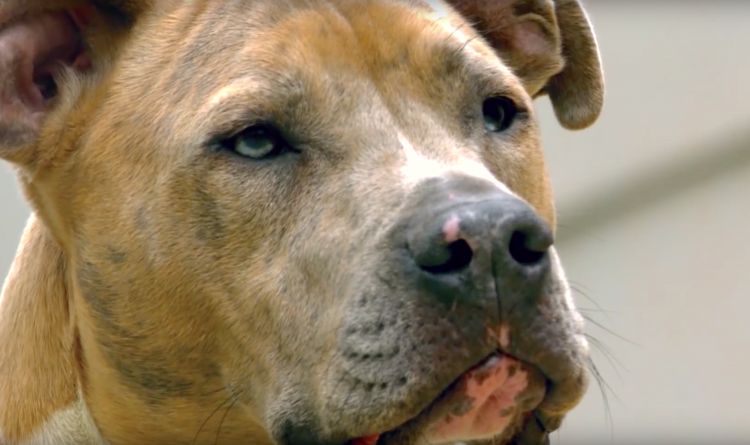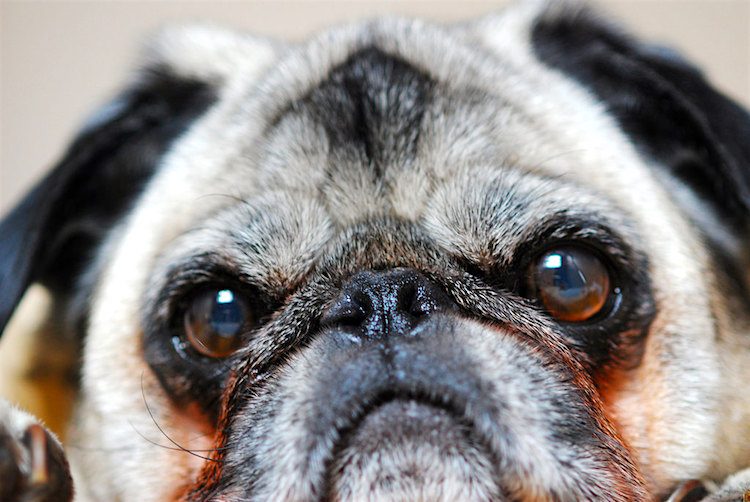
“What is entropion in dogs,” people sometimes ask me, “and can surgery fix it?”
Entropion is an eyelid disorder of dogs and, less frequently, cats that causes an inward rolling of the eyelid. As the eyelid margin inverts, hair or eyelashes can rub on the cornea, causing pain and corneal ulceration.
Entropion can affect all or part of the eyelid and any number of lids, although the lower lids are more commonly affected.
Depending on the severity of the deformity of the eyelid, the dog can experience anything from mild discomfort and excessive tearing to severe pain.
Entropion (rolling in of the lid) is the opposite of ectropion (eyelids rolling out). Some breeds, like Saint Bernards and Bloodhounds, can have both entropion and ectropion.
Primary Entropion and Breed Predisposition
Many cases of entropion in dogs that require surgery are developmental, affecting the puppy at an early age.
We believe entropion is largely genetic or breed-related.
Dog breeds most likely to have entropion include:
- Shar-Pei
- Chow Chow
- Bulldogs
- Pugs and other brachycephalic breeds
- Retrievers
- Rottweilers
Some lists include up to 25 breeds. Although entropion can occur in any breed, it is generally more of a purebred problem.
In cats, the Maine Coon is predisposed to entropion.
Your veterinarian will most likely pick up on entropion during your puppy visits or by 6 months of age, when the majority of cases become evident. Some primary (developmental) entropion will not show up until after 1 year of age, particularly in large-breed dogs.
If your vet notices a degree of entropion immediately after you have purchased a purebred puppy, chances are the breeder kept this information from you. Reputable breeders, particularly those of breeds with a genetic predisposition, should not sell a puppy with entropion without full disclosure.

Secondary Entropion in Dogs
Secondary or acquired entropion is not as common as primary in dogs. Entropion can occur secondary to:
- Trauma to the eye or eyelid
- Ocular pain or inflammation
- Systemic dermatologic conditions affecting the eye area
- Infectious eyelid and conjunctival diseases
Cats often suffer secondary entropion from severe ocular infections like herpes.
We can decrease their pain and treat corneal trauma, but these cats may be left with permanent corneal scarring and possible blindness in the affected eye, particularly if the infection was severe or if the cat suffered for a long time without treatment.
Spastic Entropion in Dogs
Spastic entropion is a term used to describe the symptom of intense blinking and not being able to hold the eye open because of pain or irritation.
Think about when you have “something in your eye” and you can’t open it until you rinse out the offending particle.
Any eye condition causing spastic entropion should be assessed immediately by your vet. The entropion should resolve once the underlying eye problem is diagnosed and treated.
Was YOUR Pet Food Recalled?
Check Now: Blue Buffalo • Science Diet • Purina • Wellness • 4health • Canine Carry Outs • Friskies • Taste of the Wild • See 200+ more brands…

How to Diagnose Entropion in Dogs
Diagnosis is generally straightforward.
In nonclinical patients — meaning the entropion is not severe enough to be causing any symptoms, such as excessive tearing or blinking — your vet will notice the lid abnormality on a simple wellness or puppy exam.
When entropion is more severe and causing ocular pain, someone might make a vet appointment because they notice their dog keeping an eye or both eyes closed, abnormal eye discharge, or excessive tearing.
Many people don’t actually see the lids turning in. They simply know “something is wrong with the dog’s eyes.”
Secondary Problems Caused by Entropion
If there is an underlying problem causing the entropion, or if the entropion has caused corneal trauma, it is extremely important to address these problems.
You may be seeing a veterinary ophthalmologist already for the entropion, but if this is a complicated case, a referral to an ophthalmologist is strongly advised.

How to Treat Entropion in Dogs
Eyelid Tacking for Entropion in Puppies
With entropion in young dogs who are candidates for surgery, we often “tack” the eyelids for several weeks or even months until the puppy is more fully developed. Tacking is a simple procedure to protect the eye and alleviate any ocular discomfort while we wait for the pup to get a little older.
Under local or light and short anesthesia, a series of removable sutures are placed above and/or below the lids to roll out the eyelids away from the cornea.
These tacking sutures may have to be replaced every 3 weeks or so, particularly in active dogs like Labrador Retrievers. The sutures themselves, I have found, rarely bother the dog. They usually do not have to spend weeks on end in an Elizabethan collar.
The eyes remain tacked until the anatomy and musculature of the face and skull mature. The puppy may actually “outgrow” the entropion, meaning the tacking may be enough treatment to correct the entropion.
Keep in mind that every entropion case is different, and it is always recommended to seek an opinion from a board-certified veterinary ophthalmologist.
The severity of the case, your vet’s level of expertise in treating entropion, and the availability and affordability of an ophthalmologist are all factors when it comes to referral.
Entropion in Dogs: Surgery
Entropion surgery is corrective eyelid surgery under general anesthesia.
It’s similar to the “eye lift” cosmetic surgery in humans.
To have the lid roll out properly, a section of dog’s skin — usually in a half-moon shape — is removed from beneath or above the affected eyelid and sutured. This procedure pulls the eyelid away from the eye and into the correct position.
Take your fingers and pinch a small section of the skin beneath your eyes. Feel your lids roll out from your eye? That is what entropion surgery does. The surgeon must carefully judge how much skin to pinch and remove — in length, shape and width.
All entropion cases are different:
- Some dogs might have the eyelid margin rolling in only at the far corner of the eye (Labradors).
- Other dogs are usually affected near their facial folds (Pugs).
- Some breeds may be so badly affected that you can barely see their eyes (Shar-Pei).
The cost of entropion surgery in dogs can vary greatly. Surgical correction of one eye could be several hundred dollars to over $1,000. The huge price difference has to do with the severity of the case, whether you are at a general or referral practice, and where you live.
Pet insurance companies may deny coverage if you did not have insurance at the time of diagnosis, making this a pre-existing condition.

Complications of Entropion Surgery in Dogs
- Under-correction means not enough skin was removed, so the dog remains with a degree of entropion. This is unfortunate because the patient may have to undergo a second surgery.
- Overcorrection occurs when the dog is left with a degree of ectropion, meaning the eyelids droop or roll out, like in a Bloodhound.
Although this is not a dangerous surgery in the sense that your vet is not in the abdomen or the chest or dealing with huge blood vessels, etc., entropion surgery in dogs requires skill.
The goals are to have the eyes look normal, not over- or under-corrected, and look identical to each other. Once I’ve corrected one eye, my challenge is always to make the second eye look identical to the first eye.
Immediately after entropion surgery, the dog will look like the surgeon has overcorrected a bit. Surgery causes some normal inflammation and slight swelling.
Folks can be startled when they pick up their dog after entropion surgery because the lids will be slightly turned out. I always warn them that the eyelids will tighten up once healing is completed and the pup will look completely normal.
How Long Does It Take a Dog to Recover From Entropion Surgery?
- During the post-op period, your pet should wear the E collar (a.k.a. the cone of shame) until sutures are removed, usually in about 10 days.
- You might be instructed to use compresses on the eyes and apply an ophthalmic lubricating ointment or antibiotic ointment.
- Pain relievers will probably be prescribed, but most dogs are feeling very good in a day’s time or so. Their eyes should certainly feel much better, but the sutures can be a little itchy until they are removed.
Prognosis for Entropion
The prognosis for entropion in dogs is good if the surgery is done properly and at the right time in the dog’s life.
If a dog has lived with entropion that has led to corneal abrasion or ulceration, corneal scarring may result.
Check out Bishop the Bulldog’s post-entropion surgery video:

Final Thoughts on Entropion in Dogs and Surgery
Eye problems in your pets should make you want to pick up the phone and call your vet. Excessive tearing, discharge or obvious changes in one or more eyes — including excessive blinking, holding an eye half-open or pawing at an eye — means a vet visit is necessary.
Think about any time your own eye has been bothering you. Even an eyelash in your eye for 10 seconds or a tiny speck or particle can drive you crazy until you flush out your eye.
A tiny corneal scratch or a case of “pink eye,” or conjunctivitis, is incredibly annoying and painful. By the time your pet is showing symptoms of an eye problem, it has most likely been going on for several hours to several days.
Take-home message: Get it checked out before more damage is done. Your dog has only one set of eyes!
References
- Bromberg, Nancy M., VMD, MS, DACVO. “Entropion.” American College of Veterinary Ophthalmologists (ACVO). https://www.acvo.org/common-conditions-1/2018/2/2/entropion?rq=entropion.
- Gelatt, Kirk, VMD, DACVO, et al. Veterinary Ophthalmology, 5th ed. Wiley-Blackwell. 2013.
- Maggs, David, BVSc(Hons), DAVCO, et al. Slatter’s Fundamentals of Veterinary Ophthalmology. Elsevier. 2017.
 This pet health content was written by a veterinarian, Dr. Debora Lichtenberg, VMD. It was last reviewed Jan. 29, 2019.
This pet health content was written by a veterinarian, Dr. Debora Lichtenberg, VMD. It was last reviewed Jan. 29, 2019. 

